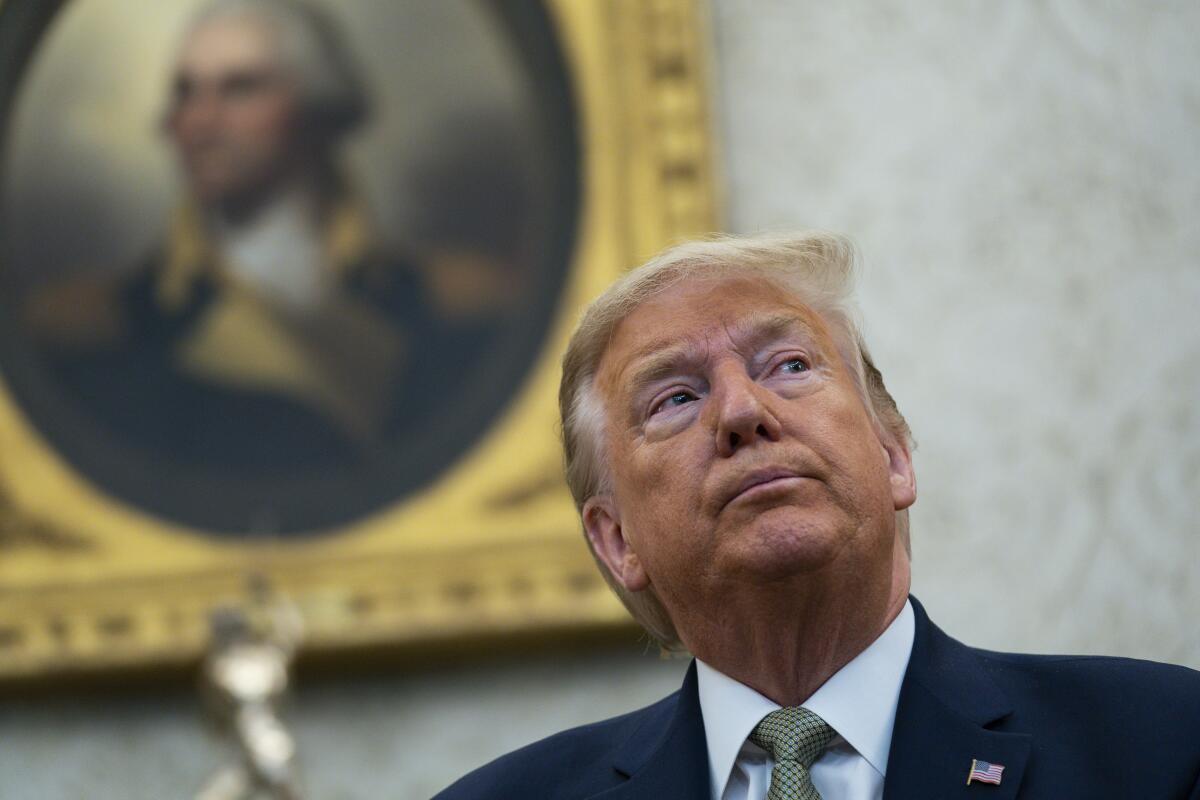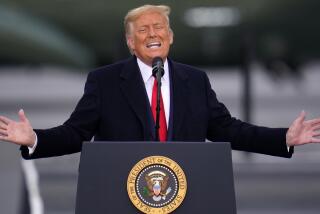Trump coronavirus response puts administration weaknesses under harsh spotlight

WASHINGTON â President Trumpâs inattention to detail, distaste for experts, need for validation and belief that he can create his own set of alternative facts have been hallmarks of his political rise.
But after three years in which daily headlines about chaos in Washington often have contrasted with a robust market on Wall Street and tranquility in much of the country, the presidentâs unorthodox approach to his job has suddenly been cast in a harsher light by a spiraling and potentially catastrophic global public health crisis.
Determined to convince the public and the markets that his administration has the threat posed by the new strain of coronavirus under control, Trumpâs public statements have more often added to the panic than calmed it.
âLack of information, not being forthright, sugarcoating information â âWe donât want people to panic!â â leads to credibility problems,â said Craig Fugate, who served as a top emergency manager for Florida Gov. Jeb Bush and then as the administrator of the Federal Emergency Management Agency under President Obama. Telling the public what you donât know and what level of confidence you have in the information you have, he continued, is also crucial.
âI tell people in public service: This is your moment of truth.â
Trump, however, has insisted on imposing his own version of truth on the situation. Even as advisors have sought to convince him of the seriousness of the public health threat, he has continued to minimize the impact, repeatedly saying that only the elderly are at real risk.
âStay calm, itâll go away,â Trump said after a visit to Capitol Hill earlier this week.
But Trump is learning that the virus wonât be contained by wishing it away. Over the weekend, he played golf at Mar-a-Lago and dined with Brazilâs President Jair Bolsonaro.
Bolsonaroâs spokesperson, who after the dinner posted a photo of himself standing next to Trump, tested positive Thursday for the virus. That news, however, has yet to compel the president to be tested for the virus himself, according to press secretary Stephanie Grisham. She said he had displayed no symptoms of illness.
It was not until Thursday that Trump agreed to quit shaking hands and start canceling campaign rallies, following major sports leagues and corporate conventions as well as his Democratic rivals.
One of the areas on which Trump has most conspicuously made statements that donât square with reality involves testing for the virus.
âWeâve done a good job on testing,â he insisted Thursday.
Almost simultaneously, Dr. Anthony Fauci, the director of the National Institute of Allergy and Infectious Diseases, told lawmakers on Capitol Hill that the dearth of available tests in the U.S. as the outbreak spreads amounts to âa failing.â
âThe system is not really geared to what we need right now,â Fauci said in testimony to the House Oversight Committee. âThat is a failing. It is a failing. Letâs admit it.â
âThe idea of anybody getting [tested] easily, the way people in other countries are doing it, weâre not set up for that,â he said. âDo I think we should be? Yes.â
The lack of easily accessible tests has become a major line of attack from Democrats and has generated rising bipartisan frustration. It has increasingly become a devastating symbol of the administrationâs overall response to the COVID-19 pandemic.
âWe have a lot of work to do,â Sen. Richard M. Burr (R-N.C.) said Thursday. Asked if he was confident the work would get done to ensure coronavirus tests are more readily available to meet the soaring demand, the senator paused for nearly 10 seconds before he spoke.
âIt would be better if we could rewind about six weeks, but we donât have that luxury.â
Inattention to detail has also hurt. Wednesday evening, as he read prepared remarks from a teleprompter during an Oval Office address, Trump made several factual errors, including a declaration that the new ban on travel from Europe would apply to trade, which he corrected in a tweet minutes after the speech.
His failure to make clear who was covered by his ban on travel from Europe to the U.S. helped generate a crush of travelers at European airports as some American citizens rushed to flights under the mistaken impression that they might not be able to return home.
Trump avoided any mention of the meager testing in the U.S. and assured the country that the decline in financial markets wasnât a crisis but âjust a temporary moment in time.â
That immediately sparked another massive sell-off.
Earlier in the crisis, Trump stated that a vaccine would soon be available, forcing his own health experts to explain that it would not be available for roughly 18 months. He also tipped his hand on the degree to which public perception drives his decisions, saying that he didnât want to allow a cruise ship with many infected passengers to dock because that would drive up the number of reported coronavirus cases in the U.S.
On Monday while returning to Washington from Florida, Trump made a point of shaking hands with supporters gathered on the airport tarmac, despite warnings to avoid close contact with others who could spread the virus. Before reporters and cameras in the Oval Office on Thursday, Trump joked that he was uncertain about shaking hands with the visiting Irish Taoiseach, Leo Varadkar.
But he continued to put a positive gloss on an increasingly dire situation, stating that the sudden drop in gasoline prices resulting from sharply lower crude oil prices and a growing reluctance to travel is âlike a tax cut.â
The persistent nonchalance from the president of the United States, increasingly off key amid a growing national concern, has complicated efforts by public health officials to deliver more essential information. That effort gets even harder because of the unofficial but obvious requirement for anyone serving in the administration not to contradict Trump publicly.
During an off-camera briefing with reporters this weekend, Secretary of Health and Human Services Alex Azar was asked about Trumpâs false statement that anyone who needs a test for the virus can have one.
Rather than simply correct the error and move on, Azar, whose standing in the White House is fragile, tried to square Trumpâs bluster with reality.
âItâs just different ways of phrasing it,â he said. âHeâs using a shorthand. What he meant to say is, âWeâre not in the way of that.ââ
Inside the West Wing, several officials are ânervous that some of the things being said on television are less than duly vetted,â said a person close to the White House who did not want to be identified to avoid burning bridges.
âEveryone is answering to an audience of one,â the person added.
Vice President Mike Pence, tapped by Trump to lead the response, has prefaced almost all of his public comments with praise for the president. During one appearance, he even backed Trumpâs decision to shake hands as appropriate âfor someone in our line of work.â
As Fugate says, âYouâve got public officials put in an awkward position where theyâre either having to testify or put out statements that are correcting the president, and now itâs looking like theyâre disagreeing with the president.â
Many of the administrationâs health officials and political appointees share a sense that the president and some of his closest aides have been slow to appreciate the seriousness of the threat, multiple White House staffers said. But there are some signals that may finally be changing, even though the window for containing the spread of the pandemic has likely passed.
âTheyâll never admit to any sort of wrongdoing, but I think theyâre pivoting to, âHereâs the real story and this is what we know,ââ said the person close to the White House.
Times staff writer Jennifer Haberkorn contributed to this report.
More to Read
Get the L.A. Times Politics newsletter
Deeply reported insights into legislation, politics and policy from Sacramento, Washington and beyond. In your inbox three times per week.
You may occasionally receive promotional content from the Los Angeles Times.












